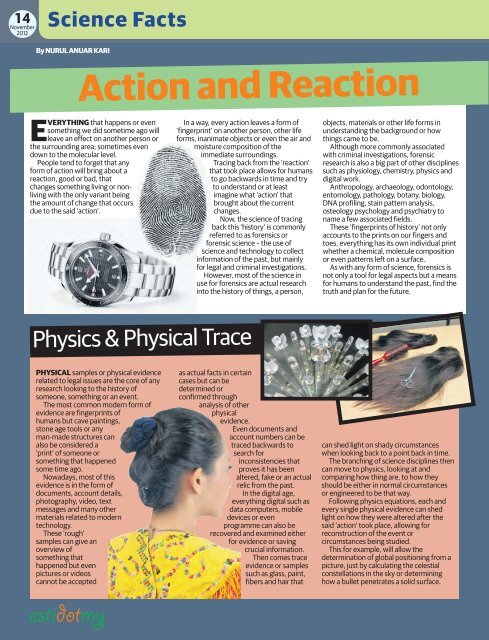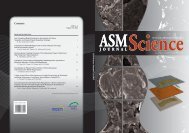Dunia Forensik - Akademi Sains Malaysia
Dunia Forensik - Akademi Sains Malaysia
Dunia Forensik - Akademi Sains Malaysia
- No tags were found...
Create successful ePaper yourself
Turn your PDF publications into a flip-book with our unique Google optimized e-Paper software.
14November2012Science FactsBy NURUL ANUAR KARIAction and reactionEVERYTHING that happens or evensomething we did sometime ago willleave an effect on another person orthe surrounding area; sometimes evendown to the molecular level.People tend to forget that anyform of action will bring about areaction, good or bad, thatchanges something living or nonlivingwith the only variant beingthe amount of change that occursdue to the said ‘action’.In a way, every action leaves a form of‘fingerprint’ on another person, other lifeforms, inanimate objects or even the air andmoisture composition of theimmediate surroundings.Tracing back from the ‘reaction’that took place allows for humansto go backwards in time and tryto understand or at leastimagine what ‘action’ thatbrought about the currentchanges.Now, the science of tracingback this ‘history’ is commonlyreferred to as forensics orforensic science – the use ofscience and technology to collectinformation of the past, but mainlyfor legal and criminal investigations.However, most of the science inuse for forensics are actual researchinto the history of things, a person,objects, materials or other life forms inunderstanding the background or howthings came to be.Although more commonly associatedwith criminal investigations, forensicresearch is also a big part of other disciplinessuch as physiology, chemistry, physics anddigital work.Anthropology, archaeology, odontology,entomology, pathology, botany, biology,DNA profiling, stain pattern analysis,osteology psychology and psychiatry toname a few associated fields.These ‘fingerprints of history’ not onlyaccounts to the prints on our fingers andtoes, everything has its own individual printwhether a chemical, molecule compositionor even patterns left on a surface.As with any form of science, forensics isnot only a tool for legal aspects but a meansfor humans to understand the past, find thetruth and plan for the future.Physics & physical tracePHYSICAL samples or physical evidencerelated to legal issues are the core of anyresearch looking to the history ofsomeone, something or an event.The most common modern form ofevidence are fingerprints ofhumans but cave paintings,stone age tools or anyman-made structures canalso be considered a‘print’ of someone orsomething that happenedsome time ago.Nowadays, most of thisevidence is in the form ofdocuments, account details,photography, video, textmessages and many othermaterials related to moderntechnology.These ‘rough’samples can give anoverview ofsomething thathappened but evenpictures or videoscannot be acceptedas actual facts in certaincases but can bedetermined orconfirmed throughanalysis of otherphysicalevidence.Even documents andaccount numbers can betraced backwards tosearch forinconsistencies thatproves it has beenaltered, fake or an actualrelic from the past.In the digital age,everything digital such asdata computers, mobiledevices or evenprogramme can also berecovered and examined eitherfor evidence or savingcrucial information.Then comes traceevidence or samplessuch as glass, paint,fibers and hair thatcan shed light on shady circumstanceswhen looking back to a point back in time.The branching of science disciplines thencan move to physics, looking at andcomparing how thing are, to how theyshould be either in normal circumstancesor engineered to be that way.Following physics equations, each andevery single physical evidence can shedlight on how they were altered after thesaid ‘action’ took place, allowing forreconstruction of the event orcircumstances being studied.This for example, will allow thedetermination of global positioning from apicture, just by calculating the celestialconstellations in the sky or determininghow a bullet penetrates a solid surface.

















